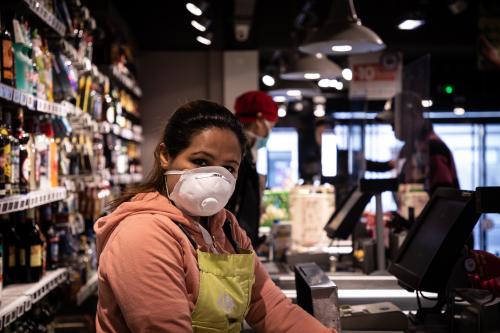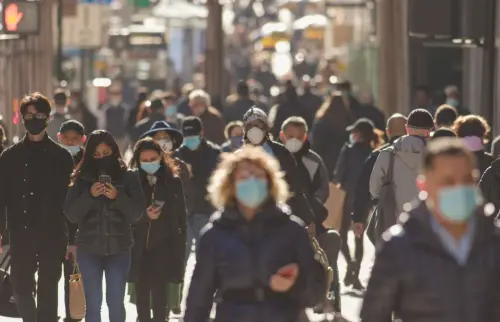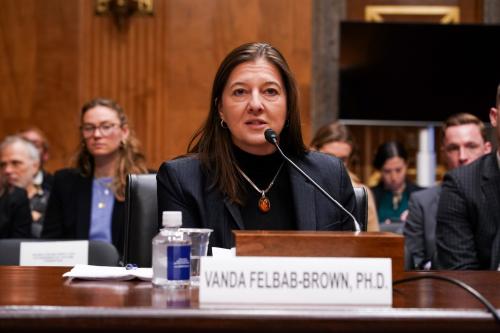The following is an excerpt from Reopening America: How to Save Lives and Livelihoods, a new report where Brookings experts offer ideas to help policymakers protect lives and save livelihoods in the midst of the current COVID-19 pandemic.
 As many countries in the world continue with lockdowns to prevent the spread of the novel coronavirus, many policymakers confront a huge challenge: how to plan for reopening their cities, states, or countries in ways that are safe and smart. Since this an unprecedented crisis, we know little about past experiences which often are a crucial input to design evidence-based policy. That gap puts an extra layer of risk—especially in terms of human lives—into every reopening decision being made.
As many countries in the world continue with lockdowns to prevent the spread of the novel coronavirus, many policymakers confront a huge challenge: how to plan for reopening their cities, states, or countries in ways that are safe and smart. Since this an unprecedented crisis, we know little about past experiences which often are a crucial input to design evidence-based policy. That gap puts an extra layer of risk—especially in terms of human lives—into every reopening decision being made.
Yet it is now increasingly clear that the coronavirus won’t disappear anytime soon, and that it is crucial to design a gradual easing of lockdowns to kickstart the local and global economies in ways that would safeguard human lives until an effective vaccine is developed and accessible at a massive scale (at best, a year from now). This is particularly important in developing countries, where economists have shown that lockdowns could also have detrimental consequences in terms of human lives among the poor. More generally, since it is widely believed that new waves of the virus will likely resurge over the next couple of years, it is crucial to have clear guidelines in place to design policies that allow us to manage the risks in a sustainable and long-term way.
While there is not a one-size-fits-all policy when it comes to reopening, my goal is to share some important metrics (though not an exhaustive list) that could be used by policymakers for gradually ending lockdowns. I categorize these metrics in three areas: by geography, industry, and population characteristics. The metrics are not mutually exclusive when it comes to policymaking as they all present important complementary information.
Before getting into each one of these indicators, however, there is one metric that is of essential consideration in every strategy: hospital capacity. One of the main purposes of lockdowns has explicitly been to flatten the curve so as not to overwhelm the local resources needed to treat the ill (e.g., hospital beds, ventilators, and, especially, healthcare personnel). For any strategy to succeed, it is crucial to try to expand and maintain the capacity of local hospitals to be able to properly treat anyone who needs care and thereby minimize fatality rates. Policymakers should continuously track the ability of the local healthcare system to deal with a sudden increase in sick people based on worst-case outcomes from models. Once this major concern is satisfied (which is not trivial in many locations), then it is time to consider the following metrics.
GEOGRAPHY-BASED METRICS
Since the virus spreads through human interaction, ending lockdowns requires the ability to track the prevalence of the disease in a geography as a whole. The main feature in relaxing lockdowns is knowing in real time the number of infected people in that population. The gold standard for this is massive testing, tracing, and targeted isolation as put forward by the epidemiologist community and beyond (including Nobel Prize Laureate Paul Romer). This plan requires being able to test everyone in a given region regularly (e.g., every couple of weeks), and making sure those who test positive enter and remain in isolation until they are confirmed as negative in a subsequent test. However, the supply of diagnostic testing remains quite limited everywhere and, according to Romer’s own calculations, rolling out massive testing in the U.S. would require resources amounting to $100 billion. Thus far, the U.S. Congress has provided $25 billion for testing purposes, which is far below what is needed.
Since the virus spreads through human interaction, ending lockdowns requires the ability to track the prevalence of the disease in a geography as a whole. The main feature in relaxing lockdowns is knowing in real time the number of infected people in that population.
A second-best metric readily applicable is tracking the R0 (“R-naught”), as suggested by Ricardo Hausmann, in similar ways that central banks track inflation rates. The R0 is the average number of other people that an infected person would infect. Any number above one implies that the disease continues to spread rapidly, while a number below one implies that the disease is contained (and will eventually disappear). Tracking daily the R0 in a given locality is not trivial as it relies on an estimation based on the daily count of infected people. Using publicly available data on infections, this website implements an algorithm to track the R0 for every U.S. state (the algorithm is open code and thus can be applied to any location in the world). In general, it shows the R0 has significantly gone down since social distancing measures took place. Yet the precision of the estimates relies on the daily tally of infected people, which in turn depends on the (limited) testing capacity of each location. If testing within one location suddenly increases or decreases, this will affect the daily count of newly-infected individuals (though the algorithm deals with this fairly well). On the other hand, if testing capacity differs significantly across locations—and it does—it poses difficulties for comparison purposes or in locations where workers mobility is intense.
Therefore, one solution for this is to implement random testing on a daily basis based on a sample of individuals large enough in a given location—which would also include in the sample asymptomatic infected individuals—that provides enough confidence in the estimates. This random testing strategy must be representative at the commuting zone level, and not less, in order to account for the possibility of high prevalence of the disease in nearby areas that share the same economic center. This random testing must be standardized internationally, too, perhaps under the lead of the World Health Organization. Only being able to track the spread of the disease in multiple locations simultaneously using trustworthy data would give national and local authorities confidence in deciding to gradually reopen the long-distance travel and international borders between locations that are deemed safe.
When the R0 of a location is below one (using a high enough confidence interval) and is in a downward trend, this provides a good rule of thumb for relaxing social distancing measures. If the R0 starts rising again, however, authorities would have a good measure to rely on to reimplement some lockdown policies as appropriate.
INDUSTRY-BASED METRICS
When thinking about gradually relaxing lockdowns in a given geography, the responsible way of doing it is to first allow for the reopening activities that are less risky in terms of their capacity to boost the spread of the disease. Thus, it is imperative to define metrics that can be used for this purpose. When it comes to the economy, only essential industries that have been operating at some capacity have remained open. But beyond these, are there any other industries that could also resume some sort of normality without posing unacceptable risks?
This post by two World Bank economists provides useful insights as it presents a classification of industries along two dimensions: face-to-face intensity as well as a work-from-home scale. Overall, firms in industries in which working from home is feasible should continue to allow for this modality at first. At the same time, it makes sense to reduce restrictions for industries for which working from home is not feasible but are less exposed to face-to-face interactions (many of them essential activities that have been active all along such as construction, agriculture, manufacturing, and utilities). Finally, there are the industries for which face-to-face interactions are intense and cannot be done from home (e.g., entertainment, restaurants, retail, and the like), and they represent the most important challenge from an economic point of view. These industries would be the last ones to resume, and therefore it is crucially important that the economic assistance from governments target firms particularly in these sectors, aiming to avoid further unemployment and try to contain the economic crisis.
This same idea can be applied more granularly to establishments within each geography using historical anonymous cell phone location data, as economists from the University of Chicago explain in this New York Times piece.
Of course, these metrics are not meant to provide a bulletproof strategy, but rather a framework to use in the policymaking process when it comes to understanding the challenges and opportunities of different industries in the context of the pandemic. It is important to consider that workers, regardless of industry, will have to continue to comply with best practice hygiene measures to avoid the spread of the disease. Moreover, the ability of workers to resume activities is directly related to the state of particular key sectors, such as the education system, as this directly affects the capacity of parents of younger children who must continue receiving as much flexibility as possible from their workplaces.
POPULATION-BASED METRICS
As we learn more about the virus and the disease, even if there is much more still to study and learn, we know that this virus poses a significant threat to particular vulnerable populations that have compromised immune systems or other co-morbidities. In the medium- and long-runs, policymakers should find ways to allow relaxing the lockdowns while still protecting the most vulnerable people in our society to avoid any unnecessary fatalities.
Is this effective? Recent research by a prominent group of MIT economists quantified a SIR model to estimate the outcomes of a strategy where lockdown is relaxed while continuing to protect the most vulnerable as they continue to follow strict social distancing rules. As the authors themselves explain:
a semi-targeted policy that involves the lockdown of those above 65 until a vaccine arrives can release the young and middle-aged groups back into the economy much more quickly, and still achieve a much lower fatality rate in the population (just above 1% of the population instead of 1.83% with the optimal uniform policy).
The authors claim that these numbers would decrease significantly in a scenario where there is little interaction between the vulnerable and the rest, and also reduce economic loss.
But, is it feasible? Yes, in some locations, but less so in others. It will ultimately depend on the demographics of a given location alongside some socio-economic factors to be tracked and studied by the policymakers. For instance, what share of the population can be classified as vulnerable and who are the other members of their households? Note that this is not only about age, but also about underlying medical conditions that often are disproportionally present among minorities 10 due to long-standing discrimination, exposure to pollution, and other factors. Furthermore, it is important to consider how to deal in areas where multigenerational households are common as they pose an additional layer of complication: the vulnerable are still at risk if their household members are out and about.
Those who are the most vulnerable to this disease are at higher risk in terms of their health, but thus far have suffered the greatest in terms of economic distress resulting from the pandemic. Therefore, in considering a gradual reopening that eases social distancing measures, policymakers must include in those plans proper safety nets to senior citizens and members of disadvantaged communities and their households. Offering full protection to these members of our societies, in any place, must be a core part of any plan under any scenario for as long as the virus is among us. This also implies not only direct transfers but also the allocation of enough resources (such as personal protective equipment and continuous access to reliable testing) to frontline essential and health workers serving vulnerable populations (for example in nursing homes, which account for a fifth of fatalities in the U.S. and up to half in Europe) so that they can continue to provide services in the safest possible way.





Commentary
Reopening America: A review of metrics to help decision-makers determine the proper pace of reopening
June 24, 2020